Elberon: “Playland of Millionaires”
History & Images
It was sometimes called “Hollywood of the East.” Back when it was a summer seashore resort during the Gilded Age.
Elberon has hosted presidents and cabinet officers, actors and industrialists, celebrities and bankers, socialites and senators. These chosen few built fantastic seashore mansions and summered here — making it a “Playland of Millionaires.” This distinctive section of Long Branch dates back over 150 years.
With a fabulous array of architectural and construction work going on in Long Branch at the turn of the century — Elberon was a spot of opportunity. The much-heralded NYC architectural firm of McKim, White and White got its real start in Elberon, designing many of the massive “seaside houses” for the rich and famous.
Lewis B. Brown is credited with developing Elberon. Born in Rahway, NJ in December 1813, legend is that “Lewis Blanchard Brown” came to Long Branch in 1863 because his “fervent abolitionist” views were unpopular in other parts of the country. According to National Park Service history about classic Jersey Shore resorts, Brown “made huge profits subdividing oceanfront plots in Elberon, a seaside neighborhood in Long Branch’s south end.” From 1866-1867, Brown acquired some 400 acres and created “Brown’s Park.” He also built Ocean Avenue in that area.
Brown was appointed a member of the inaugural Long Branch Commission in 1867 — the first attempt at municipal government in the area. He also built and owned the grand Elberon Hotel — where an American President stayed. Brown passed away in Elberon in June 1900.
Elberon is “a veritable Eden … wide streets unmarred by wires, perfect hedges and lawns, and block after block of palatial residence buildings”
—Asbury Park Press, 1907.
The “Church of the Presidents” on Ocean Avenue in Elberon — one of the city’s most historic landmarks — still stands today. Dating to 1854, the St. James Episcopal chapel was where all seven American Presidents who visited Long Branch worshiped. Potter & Robertson of New York (they also did NYC’s Metropolitan Opera House) did the design. All religious services stopped in 1953. The building was placed on the National Register of Historic Places in 1976 and was saved from a wrecker’s ball in 1999 by the Long Branch Historical Museum membership.
The Elberon Engine Company #4 was formed in April 1890 with 21 charter members. James Fay was the first company President and Foreman.
The Elberon community is also notable for sun worshipers and surf lovers. The area has three thriving private city beach clubs. The Ocean Beach Club (the city’s oldest was opened in 1906), Breakwater Beach Club and Elberon Bathing Club all still operate.
Off and on from the 1930s to the 1960s, the Elberon Civic Association and the Elberon Property Owner’s Association sought to secede from the city of Long Branch. A May 1968 Absury Park Press story on “The Mood of Elberon,” called it a “unique enclave of enthusiasts” and offered plenty of residential talk about “being apart from Long Branch.” According to that same story, Elberon itself is divided into two portions: Elberon proper, south of Park Avenue, and Elberon Village, north of Park Avenue. And even as late as 2007, there was talk of Elberon becoming part of Deal.
The boundary for the city’s Elberon section is Lake Takanassee to the north and the Borough of Deal to the south.

Elberon Big! — “Aladdin’s Castle,” 1910s. Perhaps the most elaborate house ever constructed in Long Branch.

Elberon Casino, Summer 1885 (Marriott C. Morris Collection). Built at Lincoln and Elberon Avenues in 1882 as an exclusive private men’s club. The Peabody & Stearns design fell in 1959.

Funcke Poultry Farm in Elberon, 1909. Louis Fucke started the operation. The place endured a major fire in 1917 and by July 1925, he was seeking to sell the 6-acre property for $20,000.

City school students get a spirited talk from a Long Branch firefighter at the Elberon Engine Company firehouse, May 2022. The company was founded in 1890.

Elberon Memorial Church on Park Avenue, 1940s. Dedicated in June 1886; Stanford White was the designer.

SS Rusland was shipwrecked off the Elberon coast — very near then President Grant’s cottage. Harper’s Weekly, March 1877.

Jeremiah W. Curtis house in Elberon, 1870s. In Summer 1883, Eldridge T. Gerry stayed at this Ocean Avenue cottage. It was later joined with another mansion to build the San Alfonso Retreat House.

Lewis B. Brown (1813-1900). Main developer of the city’s Elberon section. (Long Branch Daily Record/James F. Durnell Photo, August 1962).

Lewis B. Brown house on Ocean Avenue, 1877. Brown died in the home in 1900. It was wrecked and replaced with a Guggenheim family mansion in 1903.

Lake Takanassee aerial image, 1990s. The body of water is the city’s geographic boundary line separating Elberon (l) from West End (r).

Elberon home of Milton F. Untermeyer, Jr. on fire, March 1963. Untermeyer was a city councilman at the time and would be elected mayor that fall. His family built this Ocean Avenue home around 1900. A longtime stockbroker, he died in July 1980.

Elberon Memorial Church on Park Avenue, 1949. Dedicated in June 1886, in memory Moses B. Taylor, one of the wealthiest men of his times. Construction was paid for by his widow, Catherine Taylor.

Church of the Presidents, 2000s. Consecrated as the St. James Episcopal chapel in June 1879, all services stopped in 1953.

“Bertha” — a Danish bark run aground off the Elberon Hotel, May 1905. Captain William Van Brunt and his US Life-Saving Service men at #5 rescued the crew.
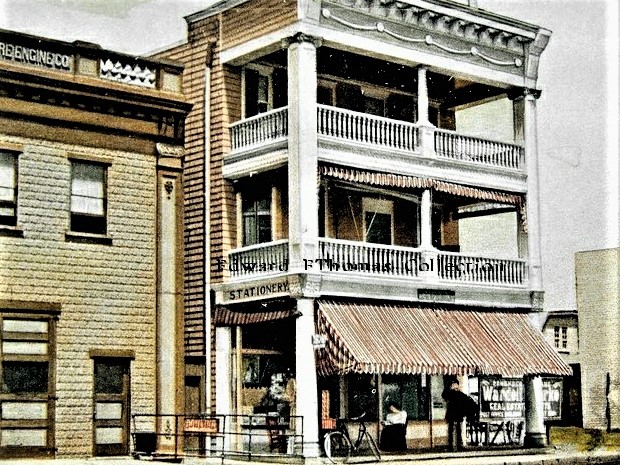
US Post Office in Elberon, early 1900s (Edward F. Thomas Photo). Walter M. Woolley was a long time superintendent of the Elberon Post Office. Upon his retirement in 1949, he was a third generation postmaster in Long Branch dating back to 1877. Elberon wasn’t consolidated in the Long Branch free postal delivery system until May 1919.

“Stratton Block” building on Lincoln Avenue. Built in 1905 by Josiah Stratton, an early and eager proponent of Elberon. It has housed many Elberon enterprises.

The Elberon house where an American President died, 1885. Charles Franklyn, president of the Cunard Ship Lines, owned this cottage — where James A. Garfield died in September 1881.
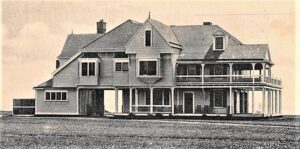
President James Garfield’s summer house in Elberon, 1910. The house was torn down in September 1920.

Elberon Casino, 1885. Built at Lincoln and Elberon Avenues in 1882. An exclusive private men’s club when opened, later it was owned for many years by Frederick Housman, a Wall Street financial wiz. Designed by Peabody and Stearns, it was torn down in 1959.

Elberon Train Station is engulfed in flames, May 1988. A new $3 million station opened in June 1996.
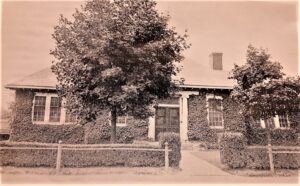
Elberon Library, 1920. The library had its grand opening in May 1911. The first president was Mrs. Katherine Kean, a wealthy summer resident and the wife of US Senator Hamilton Fish Kean (R-NJ).

Elberon Library, 1957. The library was formed in September 1900. The land had been owned by Lewis B. Brown, the founder/developer of the Elberon section of Long Branch.

Elberon library, 1910s. A Children’s Section was opened in 1957 and a Reference Room was built in 1963.

Elberon branch of the Long Branch Public Library, 1950s. The library got its start in the home of Charles and Viola Rudloff on Norwood Avenue in Ocean Twp. in 1900.

Elberon library, 2000s. Carrere & Hastings of New York City designed the library. Construction cost was $7,900.

Samuel Sachs summer home in Elberon, early 1900s. A pioneering investment banker, he co-founded with his father-in-law Goldman Sachs in 1904. Known as “Ellencourt,” the house was designed by J.H. Freedlander in 1902; it all burned in the 1950s.

Thomas T. Kinney house in Elberon, 1882. Van Campen Taylor was the architect and it cost $15,000 to build. It has since been demolished. Kinney was the editor of the Newark Daily Advertiser from 1851 to 1892.

George Pullman estate on Ocean Avenue in Elberon. Designed by Henry Jaffray in 1874, the house known as “Fairlawn” was Pullman’s main summer residence until he died in 1897. He designed and manufactured the famous Pullman sleeping car.

Myron H. Oppenheim home in Elberon, 1906. Called “Castle Wall,” it was on Park Avenue. Built in the 1890s for over $65,000, it burned in May 1938.
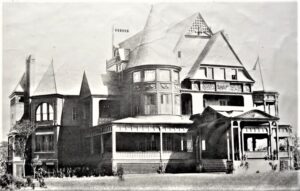
Charles T. Cook home in Elberon, 1885. He was president of Tiffany & Co. The house cost $30,000 to build.

“Aladdin’s Castle” — Designed and built by Cornelius K. Garrison in 1881. A mayor of San Francisco and early transportation tycoon, he died in 1885. Solomon Guggenheim (the fabulous NYC museum namesake) acquired the property in 1900 for his daughter who lived there until 1936.

George L. Catrambone Elementary School on Park Avenue. The K-5 school in Elberon opened in 2014. Mr. Catrambone worked in the city’s school system for nearly 40 years. The 109,000-square-foot school was built by Greyhawk Construction; the cost was $43 million. It replaced the old Elberon School that opened in January 1954 and was built for $379,000; Michael Accera was the first principal.

Ocean Beach Club on Ocean Avenue in Elberon, 2020. Organized in 1906 and still operating today. it’s the oldest beach club in Long Branch.

Breakwater Beach Club, 2017. The private club was opened in June 1957 by partners: Abe Vogel, Leopold Hechter, Irving Kaye, Harry Glassberg, Sol Tepper.

Breakwater Beach Club, 2010s. The club (l), designed by H. Irving Braun, was called a “palatial arrangement of pools, cabanas and myriad other facilities for summer recreation.”

Elberon Bathing Club on Ocean Avenue, 2019. In 1934, Gene Sperry, a wealthy New York lawyer and mayor of Deal, helped organize the club and build a facility in Long Branch on land he owned. The club was incorporated in 1943 and still operates today.

Elberon Bathing Club, 2010s. During the 1930s, it was a private beach club for the Bloomingdale family and friends — the department store magnates.

Elberon Surf Club on Ocean Avenue, 1980s. By Summer 1944, David O. Evans was operating the club which included about 60 members. In 1957, the club was incorporated as a non-profit. By December 1986, the property was sold for about $1.5 million. Beach club operations stopped shortly thereafter. A 14,000-square-foot oceanfront estate now cover the grounds.
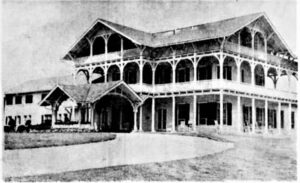
Stella Maris Retreat House, 1968. The Sisters of St. Joseph of Peace acquired the property from the estate of copper magnate Adolph Lewisohn for $14,000.

Villa Stella Maris on Ocean Avenue, 1960s. The Elberon retreat house was run by the Sisters of St. Joseph of Peace.
Over the Border in Asbury Park …

Plenty of Pool — Monte Carlo Beach Club in Asbury Park, 1950s. When Walter Reade opened his new $500,000 beach club in June 1942, he claimed to have the “world’s largest swimming pool” (salt water purified) and could accommodate up to 7,500 bathers. William Hohauser of NYC was the architect of this “engineering marvel.” Located at Ocean and 8th Avenues, the massive facility covering one city block included cabanas and bathhouses for rent, a gym, doctor-staffed ER, swimming/diving tutors, and two restaurants that served adult beverages too. The 1,250,000-gallon, 240- by 175-foot pool was temperature-controlled and ranged in depth from 4 inches to 4 feet. The first daily admission was 50 cents on weekdays and 99 cents on weekends. Reade, a pioneer in the movie theater industry (he owned 40 movie theaters in NY/NJ and several in Asbury Park and the first-ever on Broadway in Long Branch in 1912). Born in Selma, Alabama, he died in February 1952. Reade had sold the facility in 1949 to the Rediker brothers for $300,000. By the late 1960s, the club was struggling and it finally closed in 1969. The last remnants of pool and bathhouses when up in flames during a suspicious April 1971 blaze. Asbury Tower, a senior citizen 26-story high-rise, now holds the 2-acre site.














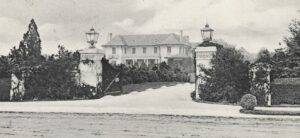
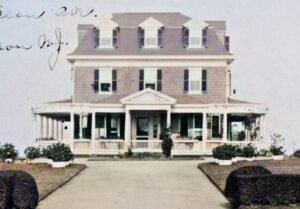












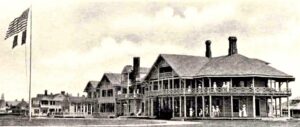

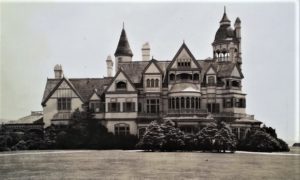


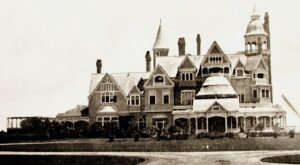



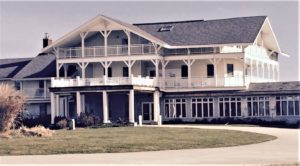
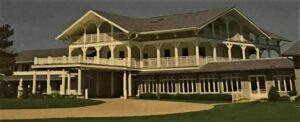





I enjoyed this history of Elberon. I also appreciated the photographs. I hope the town stays quiet but the newest groups coming in are not respectful of their neighbors and so not maintain the sense of peaceful tranquility that has historically added to the greatness of this glorious town. The quality of life has been diminishing.
I agree with Charlie about your retrospective on Elberon and Long Branch. I too enjoy the peace and quietness that these towns have provided over the many years that I’ve resided here and am hopeful that it will continue for many years to come. Charlie also mentioned the photography of the pictures which are first rate. Thank you.